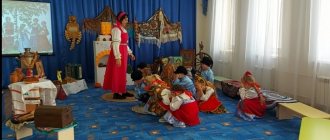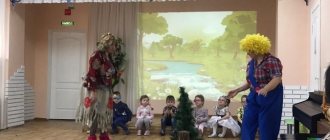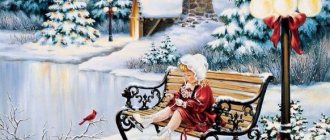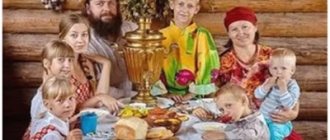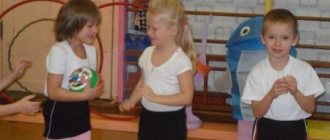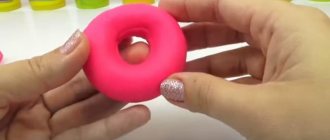MAGAZINE Preschooler.RF
Leisure summary in mathematics in the middle group “Magic Land of Shapes”DEPARTMENT OF EDUCATION OF THE CITY OF MOSCOW STATE BUDGETARY EDUCATIONAL INSTITUTION OF THE CITY OF MOSCOW “SCHOOL No. 2098 “MULTI-DISCIPLINARY EDUCATIONAL CENTER” NAMED AFTER THE HERO OF THE SOVIET UNION L.M. DOVATOR" (GBOU SCHOOL No. 2098 NAMED AFTER THE HERO OF THE SOVIET UNION L.M. DOVATOR)
Teacher Zueva E.V. Moscow, 2016
Goal: To learn to distinguish and name the following geometric shapes: square, circle, triangle, rectangle, to be able to navigate in space.
Tasks:
Educational:
Expand children's knowledge about shapes. Learn to group them by color and size.
Educational:
Develop observation and attentiveness. Develop memory, thinking and speech.
Educational:
Contribute to the development of collectivism and mutual assistance when working in a team.
Stimulate interest in mathematics.
To develop skills of cultural behavior in society.
Materials:
For children - a card with four stripes, circles (large and small) in four colors: green, blue, yellow, red; geometric figures.
For the teacher: Four baskets with stickers of shapes (for example, the first basket is a triangle, the second is a square...) Geometric shapes according to the number of children of different colors. Four bags of different colors: green, blue, yellow, red. Three keys. Soft toy.
Progress of the lesson.
The teacher invites the children to the mat; all the children come up and stand in a circle; in the center of the circle there is a teacher and invites them to go to a country that is not simple, but magical, geometric, and in this country everything consists of figures. The entrance to this land is enchanted. In order to disenchant the entrance to the magical land, you need to get three magic keys.
Q: I invite all children to hit the road soon, trials await you,
difficult tasks.
Our path will be long with obstacles. Are you guys ready to go on this journey?
D: Yes, ready.
Q: In this case, you can hit the road. The teacher and the children come to the first table. There are geometric shapes on the table.
Q: Our first task: There are different figures on the table, you need to take one piece at a time and name them.
D: Everyone takes turns taking a piece from the table and clearly names the piece they took.
Q: Well done guys, you all answered correctly. We completed the first task correctly, the path to our country is becoming shorter, we received our first key. (the key was under the last figure.) Let's move on to the second task:
On the chairs in the group there are four baskets, each with figures glued to it (circle, square, triangle, rectangle)
Q: Guys, each of you has a figure in your hands; our task is to group all the figures by size. To do this, whoever has the squares, stand next to the basket with the square. Whoever has circles, stand next to the basket with the circle. Whoever has rectangles, stand next to the basket with the rectangle. And whoever has triangles, stand next to the basket with triangles.
D: They find their baskets and stand up.
Q: Guys, if you are ready, raise your figures up. Well done, now put the pieces in your baskets. And in one of the baskets the children find the second key. Now we can move forward.
They approach the rug and there the entire rug is strewn with different figures of different colors. (while the children were completing tasks, the junior teacher poured out the figures onto the rug.)
There are four bags of different colors on the mat.
Q: Guys, this is our last task. In order to get the third key you need to collect and group the shapes by color and then put them in bags.
D: They complete the tasks and find the third key in one of the bags.
Q: Well done guys, you completed the task. The magical land is disenchanted!!!
Guys, while the country was bewitched in the “dishes” , all the cups were mixed up on the shelves. You need to help clean up the store. To do this, sit at the tables; each child has a card with four stripes and 14 circles.
The teacher explains. “These are (points to the mugs) Large and small cups.
They need to be arranged on shelves in whatever way they want.”
Options could be:
- mugs lie in disarray on every shelf
- mugs are on two shelves (large and small)
- The mugs are arranged by color on four shelves.
The teacher asks each person how he arranged the cups and on which shelf there are more and on which shelf there are fewer.
You can invite the children to arrange them so that on each shelf there are “cups” of the same color. Ask which “cups” are more: red or blue; yellow or green.
Q: Well done guys, they put things in order in the store, now residents of a magical land will be able to come to the store and easily choose cups. I suggest you tidy up your toys and go for a walk; there will be a lot more interesting things there.
You can play a game on the street: “Find the hidden toy.”
Using a counter, the leader is selected:
The seagulls lived at the pier,
The river pumped them with water.
One two three four five.
Help me count them.
The presenter goes out the door. Children hide a toy. To find it, the driver is given directions: “Go from the swing to the sandbox, turn right from the sandbox, take three steps and look there.”
Game options: The teacher indicates the direction of the asphalt with arrows of different colors.: The child indicates the direction: “First, go where the blue arrow points, then walk three steps and look there.”
When turning, the child must say where he turned: right or left.
The game is played several times at the request of the children.
| Next > |
In their activities, modern teachers carry out the mathematical development of preschoolers through “mathematical entertainment”.
In modern methodological literature, this concept is used in two main senses:
- - as a type of entertaining material, including various puzzles, mazes, mathematical jokes, games on spatial transformation, etc., widely represented in collections of entertaining mathematics, interesting in content, entertaining in form, distinguished by unusual solutions, paradoxical results
- - as a special, special form of organizing joint activities of children, exciting and attractive, organized by adults to expand, enrich or consolidate mathematical knowledge, skills and abilities and their practical application in non-standard conditions and situations.
Traditionally, entertainment organized in kindergarten is divided into types based on:
content (literary, musical, sports);
forms of conduct (attractions, competitions, leisure);
children's activities (games, fun, concerts, dramatizations);
materials and equipment (theaters of toys, dolls, pictures; radio, television programs; cinema, television films);
according to the degree of independence of children:
spectacular entertainment, concerts, performances organized and performed entirely by adults; concert-type entertainment and performances organized by adults with the participation of children;
entertainment prepared on the initiative and with the active participation of children with the help of adults and other signs.
In her works, the author Nepomnyashchaya R.L. (23;143), by analogy with children's games, highlights:
story-based entertainment;
plotless mathematical entertainment.
The author considers plot-based entertainment with elements of dramatization and role-playing games.
Plotless entertainment includes those that are structured as fun competitions, contests, and quizzes similar to sports activities.
In the pedagogical process, entertainment of a mixed nature is most often used, combining individual elements in different proportions, in which the actions of children and adults are combined. Adults usually direct the actions of children, supervise them, hold competitions, games, and introduce exciting surprises. Such entertainment, where adults participate along with children, is usually the most interesting.
Preschoolers have access to the simplest types of entertaining tasks.
In terms of developmental impact on children, I use the following main types of mathematical entertainment:
- 1. Interesting questions, joke tasks.
- 2. Puzzle problems
- 3. A group of games for composing (modeling) flat or three-dimensional images of objects (“Pythagorean Puzzle”, “Tangram”, “Pentomino”, “Cubes for Everyone”, “Corners”, etc.).
- 4. Ingenuity tasks
With the help of well-organized entertainment, it is possible to reveal the level of knowledge of both the entire group - children, and each child individually. Analysis of children’s answers and actions indicates “how well the children have mastered the program material in mathematics, whether they can apply this knowledge when solving problems formulated in a new way, whether they easily understand the meaning of practical tasks, whether they act logically and prove the correctness of their answer.” Entertainment will bring joy to children if its preparation and implementation is organized without haste and overload, and the teacher takes into account the interests and capabilities of the children.
The use of entertaining mathematical material helps to make the entertainment original and varied: mathematical games, riddles, puzzles, geometric constructors, logical games and exercises, labyrinths, puzzles, etc.
Thus, when developing the content of mathematical entertainment for preschool children, we rely on their experience, interests, capabilities and take into account not only the level of mathematical training, but also the features of the development of gaming, cognitive, motor and those types of productive activities (visual, constructive, etc.). ), which are turned on when performing various tasks.


